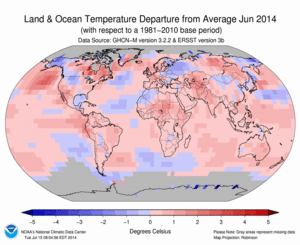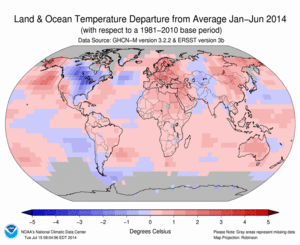NASA reports: New maps of the bedrock beneath Greenland’s ice sheet (right) have found long, deep canyons that are likely to cause ocean-feeding glaciers (left) to retreat faster and farther inland than previously thought. Credit: NASA
Scientists at NASA and the University of California, Irvine (UCI), have found that canyons under Greenland’s ocean-feeding glaciers are deeper and longer than previously thought, increasing the amount of Greenland’s estimated contribution to future sea level rise.
“The glaciers of Greenland are likely to retreat faster and farther inland than anticipated, and for much longer, according to this very different topography we have discovered,” said Mathieu Morlighem, a UCI associate project scientist who is lead author of the new research paper. The results were published Sunday in the journal Nature Geoscience.
Ice loss from Greenland has accelerated during the last few decades. However, older ice sheet models predicted the speedup would be temporary because the glaciers would soon melt back onto higher ground and stabilize. The models therefore projected Greenland’s contribution to global sea level rise would be limited.
Morlighem’s new topography shows southern Greenland’s ragged, crumbling coastline is scored by more than 100 canyons beneath glaciers that empty into the ocean. Many canyons are well below sea level as far as 60 miles (100 kilometers) inland. Higher ground, where glaciers could stabilize, is much farther from the coastline than previously thought. The finding calls into question the idea that the recent accelerated ice loss will be short-lived.
Buried under the Greenland Ice Sheet, the subcontinent’s bedrock topography has been estimated using soundings from ice-penetrating radar. However, the wet and fractured ice along the southern coastline cluttered the radar soundings so that large swaths of the bed remained invisible. To overcome that problem, Morlighem and his colleagues devised an advanced technique to create a more accurate map. The technique makes the best use of several kinds of data: ice thickness measurements derived from airborne radar; satellite radar interferometry data on the speed and direction of ice movement: and estimates of snowfall and surface melt to the sea. By combining the different types of data, they were able to map the bed topography along Greenland’s margins with unprecedented precision and detail.
“We have been able to make a quantum leap in our knowledge of bed topography beneath ice sheets in the last decade, thanks to the advent of missions like NASA’s Operation IceBridge in combination with satellite data on the speed these ice sheets are flowing,” said co-author Eric Rignot of UCI and NASA’s Jet Propulsion Laboratory, Pasadena, California.
The same research team reported new findings on glacial melt in West Antarctica last week.
“Together the papers illustrate clearly the globe’s ice sheets will contribute far more to sea level rise than current projections show,” said Rignot.
The study used synthetic aperture radar data collected in 2008-2009 by the Japanese Advanced Land Observing System Phased Array type L-band Synthetic Aperture Radar (ALOS PALSAR), the Canadian RADARSAT-1, the German TerraSAR-X, and the European Envisat Advanced Synthetic Aperture Radar (ASAR). Ice thinning rates were derived from NASA’s Airborne Topographic Mapper and ICESat data, and ice thickness data came from NASA’s Operation IceBridge airborne campaigns.











Fish Extinction
CBS news reports that a new study by Boris Worm, PhD, of Dalhousie University in Halifax, Nova Scotia predicts the extinction of all salt water fish by 2048. This extinction will be due to due to overfishing, pollution, habitat loss, and climate change.
“I was shocked and disturbed by how consistent these trends are — beyond anything we suspected,” Worm says in a news release.
“This isn’t predicted to happen. This is happening now,” study researcher Nicola Beaumont, PhD, of the Plymouth Marine Laboratory, U.K., says in a news release.
“If biodiversity continues to decline, the marine environment will not be able to sustain our way of life. Indeed, it may not be able to sustain our lives at all,” Beaumont adds.
Already, 29% of edible fish and seafood species have declined by 90% — a drop that means the collapse of these fisheries.
But the issue isn’t just having seafood on our plates. Ocean species filter toxins from the water. They protect shorelines. And they reduce the risks of algae blooms such as the red tide.
“A large and increasing proportion of our population lives close to the coast; thus the loss of services such as flood control and waste detoxification can have disastrous consequences,” Worm and colleagues say.
The researchers analyzed data from 32 experiments on different marine environments.
They then analyzed the 1,000-year history of 12 coastal regions around the world, including San Francisco and Chesapeake bays in the U.S., and the Adriatic, Baltic, and North seas in Europe.
Next, they analyzed fishery data from 64 large marine ecosystems.
And finally, they looked at the recovery of 48 protected ocean areas.
Their bottom line: Everything that lives in the ocean is important. The diversity of ocean life is the key to its survival. The areas of the ocean with the most different kinds of life are the healthiest.
But the loss of species isn’t gradual. It’s happening fast — and getting faster, the researchers say.
Worm and colleagues call for sustainable fisheries management, pollution control, habitat maintenance, and the creation of more ocean reserves.
This, they say, isn’t a cost; it’s an investment that will pay off in lower insurance costs, a sustainable fish industry, fewer natural disasters, human health, and more.
“It’s not too late. We can turn this around,” Worm says. “But less than 1% of the global ocean is effectively protected right now.”